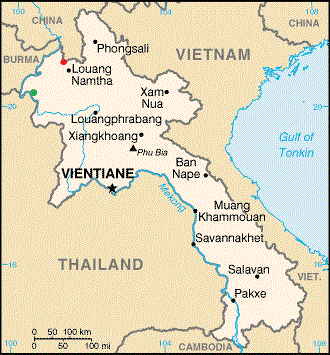Zai Jian China, Sabaidee Laos!
(“Goodbye China, Hello Laos!”)
Only a week later than expected, we finally crossed the Laos border and left China behind. The Chinese border town, Mohan, has been under serious development for some time, presumably to appear as impressive as possible. But, typically for China, it comes off more tacky and rundown than they probably want. The development is very superficial, big new buildings are left empty and broad boulevards look silly lacking the traffic they’re clearly designed for.
Our cheap hotel was very typical, shabby whitewashed walls, hard beds, dirty bathroom…and a huge color TV. It wasn’t a particularly comfortable night, and in the morning we were happy to leave and head for the huge customs building that overshadows the town to the south. For an unknown reason, money could not be changed in the two banks located in a border town and instead we used the “change money!” ladies standing around the border pestering everyone. At least it was a breeze to get through Chinese customs. Most of our fellow border crossers were Laos citizens or Thai tourists.
On the other side, the Laos customs building (see: shack) stood in stark contrast to the Chinese behemoth. Getting our visas on arrival was easy, though pricier than expected at $45 each, and we were back on the road in no time.
We hadn’t really thought past the Laos customs as to where we would head next, other than a general desire to head west towards a city called Huay Xai on the banks of the Mekong on the Thai border. Almost immediately mile markers spoke of Luang Prabang, which we recognized from the guidebooks to be a backpacker haven so we decided to head there. We were pleasantly surprised it was only 32 miles away and the roads were in great shape. We had half expected our nice recently sealed highway to turn into a dirt track.

Map Above: The red dot was where we entered, we’re currently in Luang Namtha, and the green dot is approximately where Huay Xai is.. our ultimate destination in the next couple of days.
The contrast between the customs buildings was not the only one we noticed. Unlike China, where concrete is King, settlements along the road seemed to be much more varied in style. Buildings ranged from the very ramshackle and basic (plywood nailed to a bamboo frame), to almost European – brick and wood, tastefully designed, and finished with pretty details such as wooden shutters and flower gardens. However, the majority of the route passed through villages consisting of bamboo huts on stilts.
Laos is around 75% unmanaged vegetation, and this was noticeable even so close to the border, despite some areas that had been heavily logged and deforested. The Laos government is attempting to halt the spread of logging and preserve its natural forests, but in many areas logging represents the main livelihood of the locals, and as such is hard to effectively control. There are a number of “protected areas” that have become one of the major draws for tourists. One of which, the densely jungled Namha region, is the attraction for backpackers going to Luang Namtha. It is home to tigers, monkeys, gaurs (the worlds largest wild cow), and many more exciting things.
Everyone in the villages along the road seemed very happy to see us. Instead of the suspicious stares and screams of “Lao Wai!” (‘foreigner’ in Chinese), we got smiles, waves, and cries of “Sabaidee!” (‘hello’ in Lao). Contrary to expectation, everything seems more expensive here so perhaps that’s why they were pleased to see us. Laos is currently struggling to pull itself off the list of the 20 poorest nations in the world. It was one of the few countries not hit by the world economic crisis, and tourism is clearly booming, so perhaps it has a decent chance.
Luang Namtha turned out to be the haven it claimed to be, its main road lined with guesthouses, restaurants offering western food, and tourism offices. We found the guesthouse most recommended by Lonely Planet, the Zuela Guesthouse, and we too would recommend it. Set in a lovely courtyard off the road, it consists of three traditional brick and wood houses, one of which is the restaurant we’re writing this from. Perhaps due to the influence of western tourists (mostly Europeans) this guesthouse clearly has different priorities than the Chinese hotels. Cleanliness, nice lighting, effective mosquito netting and atmosphere take priority over garish marbled surfaces, free one-use toiletries and big TVs. Not having a TV and bringing our own soap is worth not battling cockroaches for the bathroom.
The contrast with China is as stark as the government officials in Mohan clearly want it to be, though not in the direction they hoped. Having travelled through small town China for 3 weeks, we excused a lot by saying that the region was poor. The dirtiness, the lack of character, the attitude of locals, and the fact that everywhere seemed basically the same. Comparing it to what we have seen of Laos so far, this excuse doesn’t seem to hold water. It seems that somewhere along the line China has lost some of its soul. Perhaps it was sold to the devil as the price for their rapid modernization.
Final few pictures in China can be found here

Leave a Reply